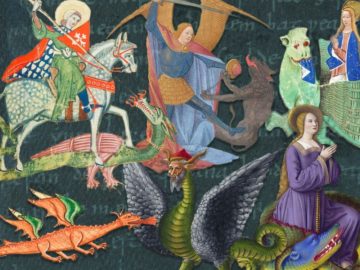Perry and Gabriele in Smithsonian:
 The dragon resting on its golden hoard. The gallant knight charging to rescue the maiden from the scaly beast. These are images long associated with the European Middle Ages, yet most (all) medieval people went their whole lives without meeting even a single winged, fire-breathing behemoth. Dragons and other monsters, nights dark and full of terror, lurked largely in the domain of stories—tales, filtered through the intervening centuries and our own interests, that remain with us today.
The dragon resting on its golden hoard. The gallant knight charging to rescue the maiden from the scaly beast. These are images long associated with the European Middle Ages, yet most (all) medieval people went their whole lives without meeting even a single winged, fire-breathing behemoth. Dragons and other monsters, nights dark and full of terror, lurked largely in the domain of stories—tales, filtered through the intervening centuries and our own interests, that remain with us today.
As Halloween approaches, we’re naturally thinking about scary stories. Though horror today is most often about entertainment—the thrill of the jump scare or the suspense of the thriller—it hasn’t always been that way. In the European Middle Ages, monster stories served as religious teaching tools, offering examples of what not to do, manifestations of the threats posed by the supernatural and the diabolical, and metaphors for the evil humans do to one another.
Medieval people told tales about all kinds of monsters, including ghosts, werewolves and women who turned into serpents on Saturdays. But dragons held a special place in both the modern imagination and the medieval one. As historian Scott Bruce, editor of the newly released Penguin Book of Dragons, explains, dragons in the medieval mindset stood “as the enemies of humankind, against which we measure the prowess of our heroes.” As such, they were neatly and easily folded into Christian tradition, “often cast … as agents of the devil or demons in disguise.”
More here.
